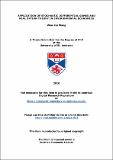Files in this item
Application of stochastic differential games and real option theory in environmental economics
Item metadata
| dc.contributor.advisor | Ewald, Christian-Oliver | |
| dc.contributor.author | Wang, Wen-Kai | |
| dc.coverage.spatial | 163 | en_US |
| dc.date.accessioned | 2010-06-03T11:47:11Z | |
| dc.date.available | 2010-06-03T11:47:11Z | |
| dc.date.issued | 2009-12-23 | |
| dc.identifier | uk.bl.ethos.552363 | |
| dc.identifier.uri | https://hdl.handle.net/10023/893 | |
| dc.description.abstract | This thesis presents several problems based on papers written jointly by the author and Dr. Christian-Oliver Ewald. Firstly, the author extends the model presented by Fershtman and Nitzan (1991), which studies a deterministic differential public good game. Two types of volatility are considered. In the first case the volatility of the diffusion term is dependent on the current level of public good, while in the second case the volatility is dependent on the current rate of public good provision by the agents. The result in the latter case is qualitatively different from the first one. These results are discussed in detail, along with numerical examples. Secondly, two existing lines of research in game theoretic studies of fisheries are combined and extended. The first line of research is the inclusion of the aspect of predation and the consideration of multi-species fisheries within classical game theoretic fishery models. The second line of research includes continuous time and uncertainty. This thesis considers a two species fishery game and compares the results of this with several cases. Thirdly, a model of a fishery is developed in which the dynamic of the unharvested fish population is given by the stochastic logistic growth equation and it is assumed that the fishery harvests the fish population following a constant effort strategy. Explicit formulas for optimal fishing effort are derived in problems considered and the effects of uncertainty, risk aversion and mean reversion speed on fishing efforts are investigated. Fourthly, a Dixit and Pindyck type irreversible investment problem in continuous time is solved, using the assumption that the project value follows a Cox-Ingersoll- Ross process. This solution differs from the two classical cases of geometric Brownian motion and geometric mean reversion and these differences are examined. The aim is to find the optimal stopping time, which can be applied to the problem of extracting resources. | en_US |
| dc.language.iso | en | en_US |
| dc.publisher | University of St Andrews | |
| dc.rights | Creative Commons Attribution-NonCommercial-NoDerivs 3.0 Unported | |
| dc.rights.uri | http://creativecommons.org/licenses/by-nc-nd/3.0/ | |
| dc.subject | Differential games | en_US |
| dc.subject | Real options | en_US |
| dc.subject | Stochastic optimal control | en_US |
| dc.subject | Public goods | en_US |
| dc.subject | Fisheries | en_US |
| dc.subject | Maximum sustainable yields | en_US |
| dc.subject | Cox-Ross-Ingersoll process | en_US |
| dc.subject | Environmental economics | en_US |
| dc.subject.lcc | HD75.5W26 | |
| dc.subject.lcsh | Environmental economics--Mathematical model | en_US |
| dc.subject.lcsh | Real options (Finance)--Mathematical models | en_US |
| dc.subject.lcsh | Differential games | en_US |
| dc.subject.lcsh | Stochastic processes | en_US |
| dc.subject.lcsh | Fisheries--Economic aspects--Mathematical models | en_US |
| dc.title | Application of stochastic differential games and real option theory in environmental economics | en_US |
| dc.type | Thesis | en_US |
| dc.type.qualificationlevel | Doctoral | en_US |
| dc.type.qualificationname | PhD Doctor of Philosophy | en_US |
| dc.publisher.institution | The University of St Andrews | en_US |
| dc.publisher.department | School of Economics and Finance | en_US |
This item appears in the following Collection(s)
Except where otherwise noted within the work, this item's licence for re-use is described as Creative Commons Attribution-NonCommercial-NoDerivs 3.0 Unported
Items in the St Andrews Research Repository are protected by copyright, with all rights reserved, unless otherwise indicated.


